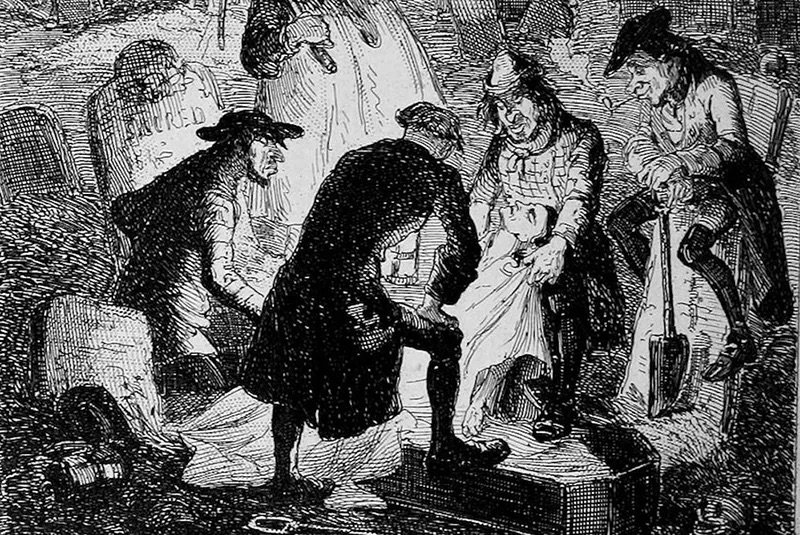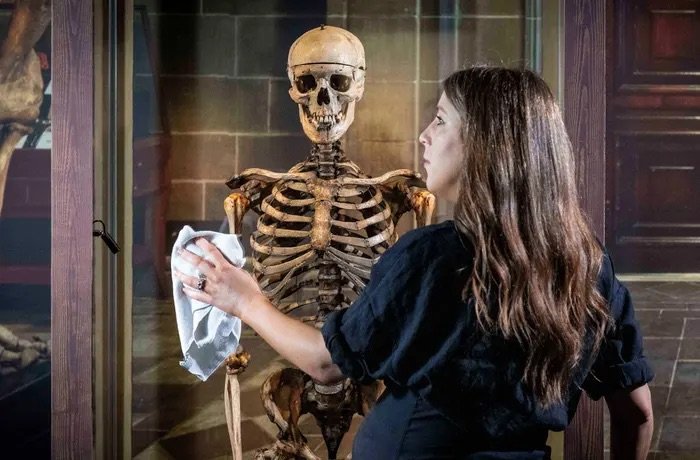A crisp breeze ices the tips of your fingers as you make your way into a glowing doorway and a gentle hum of voices greets you. You strategically angle for the high counter where you wait a moment before the bartender notices you and asks what you want. Maybe it’s a gin and tonic, a Negroni, or an old fashioned. But with the haunting cold still at your back, you implore the bartender to “make it stiff.”
The bartender chuckles, leans forward with eyebrows elevated, and murmurs, “You know where that saying comes from?”
“It’s just another term for strong, right?”
“Not quite. Back in the day, grave robbers used to transport stolen bodies in barrels of whiskey to manage the smell. Then they would turn around and sell the whiskey to unsuspecting patrons. ‘Stiff’ drink, get it?”
This morbid folktale spins together both a truth and a lie. In reality, this turn of phrase predates these nefarious activities. However, the clever pun does convey an element of truth. Resurrectionists occasionally transported pilfered bodies in barrels of whiskey [1]. However, they more commonly applied a wider range of methods in their constant effort to meet a high demand for cadavers amongst academic communities.
Image 1. “Resurrectionists” stealing dead bodies from a graveyard. Source.
Superstitions and religious beliefs collided, producing general antagonism towards dissection as a desecration of the deceased [2]. Hannibal Hamlin, a Yale historian, explains that, “The Doctor of Physic was held in high esteem; but the dissection of a cadaver by the surgeon or anatomist was, in general, considered a nefarious and unmentionable business” [3]. Without any lawful methods for procuring bodies to study, medical societies at academic institutions turned to less ethical tactics.
Image 2. William Hunter is run off by a night watchman. Source.
A combination of seasoned professionals and desperate students rose to the challenge, often drinking beforehand to numb their conscience [4]. A proficient grave robber could extract a body from its grave in roughly fifteen minutes and, during the late 1700s in Great Britain, could expect an equivalent of close to $250 per body [5]. The grotesque process often consisted of unearthing the head of the coffin, prying open or breaking the lid, hooking the neck or armpit of the body, and then pulling the body out using a rope [6].
Many resurrectionists managed to avoid suspicion and so they disappeared into the annals of history. But a few infamous names are remembered to this day, with Burke and Hare being amongst the most well known. During the early 1800s, Edinburgh blossomed as a center for the study of anatomy with Robert Knox at the forefront of these endeavors [7]. He came to work with Burke and Hare and, in doing so, perhaps unknowingly endorsed the murder of sixteen individuals. Rather than wait for people to die, Burke and Hare decided to speed up the process by discretely murdering a series of lodgers in Hare’s house [8]. In true “the punishment shall fit the crime” fashion, the judge deemed that Burke’s body should be “publicly dissected and anatomized” with his skeleton still viewable at the Anatomical Museum of the Edinburgh Medical School” [9].
Image 3. Curator Ailsa Hutton with William Burke’s skeleton. Source.
Similar to the uproar surrounding Burke and Hare, many riots occurred throughout history in protest of dissection. These violent responses seemed appropriate and even necessary when politicians and lawyers turned a blind eye to their grave robbing epidemic [10]. Over seventeen riots occurred in the United Stated before the Civil War, including the New Haven dissection riots of 1824 and the New York doctors’ riot of 1788 where Alexander Hamilton pleaded with rioters on the steps of Columbia College in an attempt to save the school [11].
When the vitriol and risk of violence could no longer be overlooked, governments began to negotiate solutions. This often resulted in anatomy acts that allowed medical schools to use unclaimed bodies from hospitals or poorhouses [12]. With this change, grave robbing substantially decreased and the families of loved ones no longer needed to resort to guarding or caging the graves of the dead [13].
Image 4. Mortsafes at Cluny kirkyard. Source.
In 1832 the utilitarian philosopher Jeremy Benthem became the first to donate his body to scientific research in an effort to improve support for dissection while honoring the legacies of the dead [14]. While uncommon for many subsequent decades, this eventually transformed into the primary method for acquiring cadavers and grave robbing largely became a thing of the past. But even to this day, when the nights are long and the warmth of whiskey sounds particularly enticing, the “old-timers” near the Hopkins medical school might pass on a warning from their childhood: to hurry home lest a doctor “catch you and cut you up” [15].
Sources
[1] Pietila, Antero. “In Need of Cadavers, 19th-Century Medical Students Raided Baltimore’s Graves.” Smithsonian Magazine, 25 Oct. 2018, www.smithsonianmag.com/history/in-need-cadavers-19th-century-medical-students-raided-baltimores-graves-180970629/.
[2] Kean, Sam. “The Anatomy Riot of 1788.” Science History Institute, 4 Feb. 2020, www.sciencehistory.org/stories/magazine/the-anatomy-riot-of-1788/.
[3] “Anatomy of an Insurrection.” Yale Medicine Magazine, 2002, medicine.yale.edu/news/yale-medicine-magazine/article/anatomy-of-an-insurrection/.
[4] Kean, Sam. “The Anatomy Riot of 1788.” Science History Institute, 4 Feb. 2020, www.sciencehistory.org/stories/magazine/the-anatomy-riot-of-1788/.
[5] Kean, Sam. “The Anatomy Riot of 1788.” Science History Institute, 4 Feb. 2020, www.sciencehistory.org/stories/magazine/the-anatomy-riot-of-1788/.
[6] Pietila, Antero. “In Need of Cadavers, 19th-Century Medical Students Raided Baltimore’s Graves.” Smithsonian Magazine, 25 Oct. 2018, www.smithsonianmag.com/history/in-need-cadavers-19th-century-medical-students-raided-baltimores-graves-180970629/.
[7] Donaldson, Kayleigh. “A Brief History of Burke and Hare, Scotland’s Most Infamous Murdering Grave Robbers.” SYFY, 8 Jan. 2019, www.syfy.com/syfy-wire/a-brief-history-of-burke-and-hare-scotlands-most-infamous-murdering-grave-robbers.
[8] Donaldson, Kayleigh. “A Brief History of Burke and Hare, Scotland’s Most Infamous Murdering Grave Robbers.” SYFY, 8 Jan. 2019, www.syfy.com/syfy-wire/a-brief-history-of-burke-and-hare-scotlands-most-infamous-murdering-grave-robbers.
[9] Donaldson, Kayleigh. “A Brief History of Burke and Hare, Scotland’s Most Infamous Murdering Grave Robbers.” SYFY, 8 Jan. 2019, www.syfy.com/syfy-wire/a-brief-history-of-burke-and-hare-scotlands-most-infamous-murdering-grave-robbers.
[10] Pietila, Antero. “In Need of Cadavers, 19th-Century Medical Students Raided Baltimore’s Graves.” Smithsonian Magazine, 25 Oct. 2018, www.smithsonianmag.com/history/in-need-cadavers-19th-century-medical-students-raided-baltimores-graves-180970629/.
[11] Kean, Sam. “The Anatomy Riot of 1788.” Science History Institute, 4 Feb. 2020, www.sciencehistory.org/stories/magazine/the-anatomy-riot-of-1788/.
[12] Kean, Sam. “The Anatomy Riot of 1788.” Science History Institute, 4 Feb. 2020, www.sciencehistory.org/stories/magazine/the-anatomy-riot-of-1788/.
[13] Donaldson, Kayleigh. “A Brief History of Burke and Hare, Scotland’s Most Infamous Murdering Grave Robbers.” SYFY, 8 Jan. 2019, www.syfy.com/syfy-wire/a-brief-history-of-burke-and-hare-scotlands-most-infamous-murdering-grave-robbers.
[14] Kean, Sam. “The Anatomy Riot of 1788.” Science History Institute, 4 Feb. 2020, www.sciencehistory.org/stories/magazine/the-anatomy-riot-of-1788/.
[15] Pietila, Antero. “In Need of Cadavers, 19th-Century Medical Students Raided Baltimore’s Graves.” Smithsonian Magazine, 25 Oct. 2018, www.smithsonianmag.com/history/in-need-cadavers-19th-century-medical-students-raided-baltimores-graves-180970629/.




